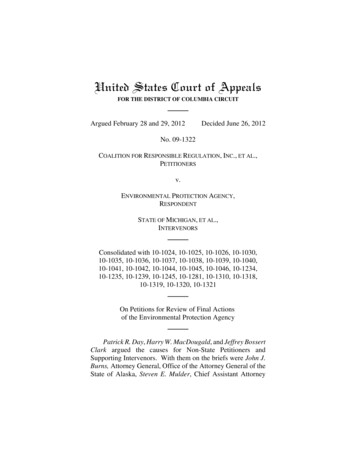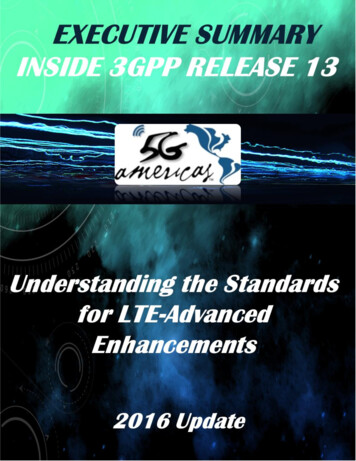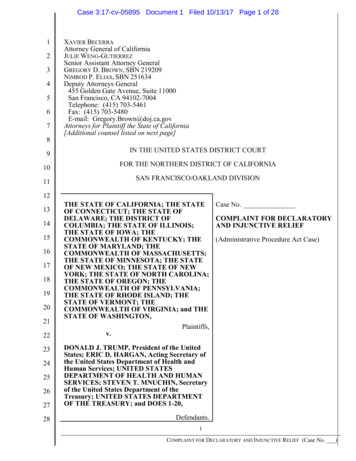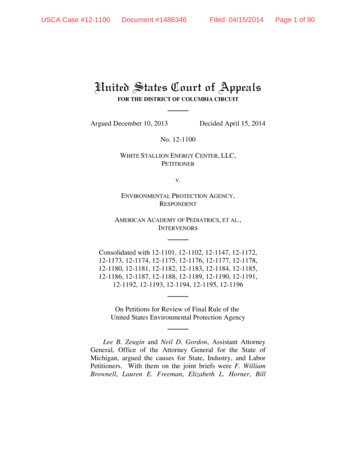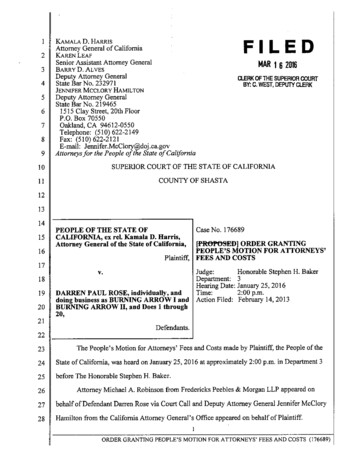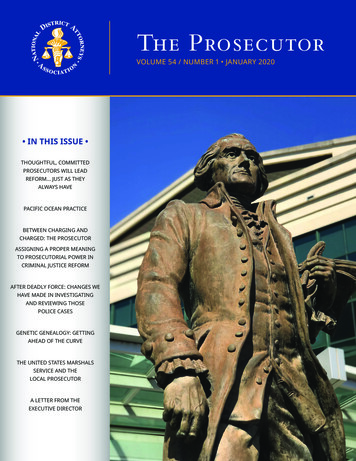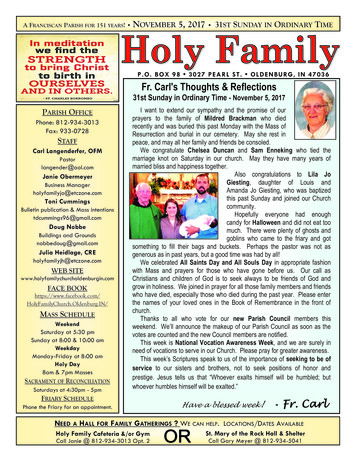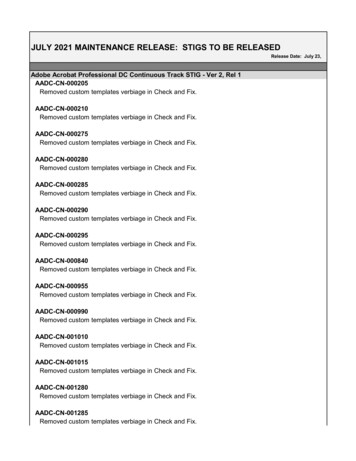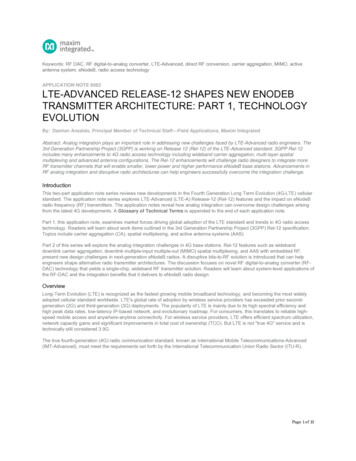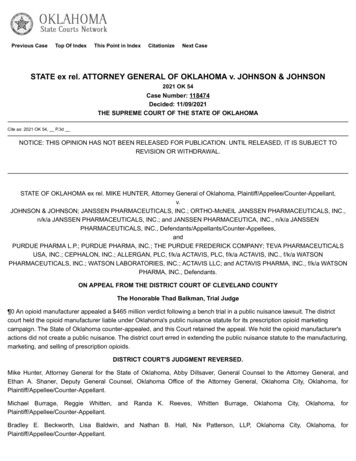
Transcription
Previous CaseTop Of IndexThis Point in IndexCitationizeNext CaseSTATE ex rel. ATTORNEY GENERAL OF OKLAHOMA v. JOHNSON & JOHNSON2021 OK 54Case Number: 118474Decided: 11/09/2021THE SUPREME COURT OF THE STATE OF OKLAHOMACite as: 2021 OK 54, P.3dNOTICE: THIS OPINION HAS NOT BEEN RELEASED FOR PUBLICATION. UNTIL RELEASED, IT IS SUBJECT TOREVISION OR WITHDRAWAL.STATE OF OKLAHOMA ex rel. MIKE HUNTER, Attorney General of Oklahoma, Plaintiff/Appellee/Counter-Appellant,v.JOHNSON & JOHNSON; JANSSEN PHARMACEUTICALS, INC.; ORTHO-McNEIL JANSSEN PHARMACEUTICALS, INC.,n/k/a JANSSEN PHARMACEUTICALS, INC.; and JANSSEN PHARMACEUTICA, INC., n/k/a JANSSENPHARMACEUTICALS, INC., Defendants/Appellants/Counter-Appellees,andPURDUE PHARMA L.P.; PURDUE PHARMA, INC.; THE PURDUE FREDERICK COMPANY; TEVA PHARMACEUTICALSUSA, INC.; CEPHALON, INC.; ALLERGAN, PLC, f/k/a ACTAVIS, PLC, f/k/a ACTAVIS, INC., f/k/a WATSONPHARMACEUTICALS, INC.; WATSON LABORATORIES, INC.; ACTAVIS LLC; and ACTAVIS PHARMA, INC., f/k/a WATSONPHARMA, INC., Defendants.ON APPEAL FROM THE DISTRICT COURT OF CLEVELAND COUNTYThe Honorable Thad Balkman, Trial Judge¶0 An opioid manufacturer appealed a 465 million verdict following a bench trial in a public nuisance lawsuit. The districtcourt held the opioid manufacturer liable under Oklahoma's public nuisance statute for its prescription opioid marketingcampaign. The State of Oklahoma counter-appealed, and this Court retained the appeal. We hold the opioid manufacturer'sactions did not create a public nuisance. The district court erred in extending the public nuisance statute to the manufacturing,marketing, and selling of prescription opioids.DISTRICT COURT'S JUDGMENT REVERSED.Mike Hunter, Attorney General for the State of Oklahoma, Abby Dillsaver, General Counsel to the Attorney General, andEthan A. Shaner, Deputy General Counsel, Oklahoma Office of the Attorney General, Oklahoma City, Oklahoma, forPlaintiff/Appellee/Counter-Appellant.Michael Burrage, Reggie Whitten, and Randa K. Reeves, Whitten Burrage, Oklahoma City, Oklahoma, forPlaintiff/Appellee/Counter-Appellant.Bradley E. Beckworth, Lisa Baldwin, and Nathan B. Hall, Nix Patterson, LLP, Oklahoma City, Oklahoma, forPlaintiff/Appellee/Counter-Appellant.
John Thorne, Brendan J. Crimmins, and Ariela M. Migdal, Kellogg, Hansen, Todd, Figel & Frederick, P.L.L.C., Washington,D.C., for Plaintiff/Appellee/Counter-Appellant.Larry D. Ottaway, Amy Sherry Fischer, and Andrew M. Bowman, Foliart, Huff, Ottaway & Bottom, Oklahoma City, Oklahoma,for Defendants/Appellants/Counter-Appellees.Andrew W. Lester and A.J. Ferate, Spencer Fane LLP, Oklahoma City, Oklahoma, for Defendants/Appellants/CounterAppellees.Benjamin H. Odom, John H. Sparks, and Michael W. Ridgeway, Odom & Sparks, PLLC, Norman, Oklahoma, forDefendants/Appellants/Counter-Appellees.Charles C. Lifland and Jonathan phen D. Brody, O'Melveny & Myers, LLP, Washington, D.C., for Defendants/Appellants/Counter-Appellees.Jeffrey L. Fisher, O'Melveny & Myers, LLP, Menlo Park, California, for Defendants/ Appellants/Counter-Appellees.Winchester, J.¶1 An opioid drug epidemic exists in the United States. Oklahoma has experienced abuse and misuse of opioid medications,opioid use disorder, and thousands of opioid-related deaths in the past two decades. Specifically, opioid-related deathsincreased during the early 2000s, plateaued around 2007, and then declined. 1 What we cannot ignore is that improper use ofprescription opioids led to many of these deaths; few deaths occurred when individuals used pharmaceutical opioids asprescribed. We also cannot disregard that chronic pain affects millions of Americans. It is a persistent and costly healthcondition, and opioids are currently a vital treatment option for pain. The U.S. Food and Drug Administration ("FDA") hasendorsed properly managed medical use of opioids (taken as prescribed) as safe, effective pain management, and rarelyaddictive. 2 Yet opioid abuse is still prevalent and has become a complex social problem.¶2 To address this problem, the State of Oklahoma ex rel. Mike Hunter, Attorney General of Oklahoma ("State"), sued threeprescription opioid manufacturers and requested that the district court hold opioid manufacturers liable for violatingOklahoma's public nuisance statute. The question before the Court is whether the conduct of an opioid manufacturer inmarketing and selling its products constituted a public nuisance under 50 O.S.2011, §§ 1 & 2. We hold that the district court'sexpansion of public nuisance law went too far. Oklahoma public nuisance law does not extend to the manufacturing,marketing, and selling of prescription opioids.FACTS AND PROCEDURE¶3 Since the mid-1990s, Appellant Janssen Pharmaceuticals, Inc. (and its related entities), a wholly-owned subsidiary ofAppellant Johnson & Johnson (collectively "J&J"), has manufactured, marketed, and sold prescription opioids in Oklahoma.J&J specifically manufactured two FDA-approved Schedule II 3 opioid medications: (1) Duragesic--a transdermal patch thatprovides a controlled dose of pharmaceutical fentanyl 4 ; and (2) Nucynta and Nucynta ER--tablets with tapentadol. 5 J&J alsomanufactured a Schedule IV opioid medication: Ultram and Ultram Extended Release--tablets with tramadol. 6 J&J marketedseveral other medications containing tramadol.¶4 The State presented evidence that J&J used branded and unbranded marketing, which actively promoted the concept thatphysicians were undertreating pain. Ultimately, the State argued J&J overstated the benefits of opioid use, downplayed thedangers, and failed to disclose the lack of evidence supporting long-term use in the interest of increasing J&J's profits.¶5 J&J no longer promotes any prescription opioids and has not done so for several years. J&J ceased to actively promote itsSchedule II branded products by 2015. Specifically, J&J ceased to actively promote Duragesic in 2007, and it divested its U.S.Nucynta product line in 2015. Even with J&J's marketing practices, these two Schedule II medications amounted to less than1% of all Oklahoma opioid prescriptions. Overall, J&J sold only 3% of all prescription opioids statewide, leaving the otheropioid manufacturers named in this suit responsible for selling 97% of all prescription opioids. 7
¶6 On June 30, 2017, the State sued three opioid manufacturers--J&J (and its related entities 8 ), Purdue Pharma L.P. (and itsrelated entities 9 ), and Teva Pharmaceuticals USA, Inc. (and its related entities 10 ) alleging the companies deceptivelymarketed opioids in Oklahoma. The State settled with the other opioid manufacturers 11 and eventually dismissed all claimsagainst J&J except public nuisance. The district court conducted a 33-day bench trial with the single issue being whether J&Jwas responsible for creating a public nuisance in the marketing and selling of its opioid products. The district court held J&Jliable under Oklahoma's public nuisance statute for conducting "false, misleading, and dangerous marketing campaigns"about prescription opioids. The district court ordered that J&J pay 465 million to fund one year of the State's AbatementPlan, which consisted of the district court appropriating money to 21 government programs for services to combat opioidabuse. 12 The amount of the judgment against J&J was not based on J&J's percentage of prescription opioids sold. Thedistrict court also did not take into consideration or grant J&J a set-off for the settlements the State had entered into with theother opioid manufacturers. Instead, the district court held J&J responsible to abate alleged harms done by all opioids, not justopioids manufactured and sold by J&J.¶7 J&J appealed. The State cross-appealed contending that J&J should be responsible to pay for 20 years of the State'sAbatement Plan, or approximately 9.3 billion to fund government programs. This Court retained the appeal.¶8 The issue before this Court is whether the district court correctly determined that J&J's actions in marketing and sellingprescription opioids created a public nuisance. We hold it did not. The nature of the nuisance claim pled by the State is themarketing, selling, and overprescribing of opioids manufactured by J&J. This Court has not extended the public nuisancestatute to the manufacturing, marketing, and selling of products, and we reject the State's invitation to expand Oklahoma'spublic nuisance law.¶9 In reaching this decision, we do not minimize the severity of the harm that thousands of Oklahoma citizens have sufferedbecause of opioids. However grave the problem of opioid addiction is in Oklahoma, public nuisance law does not provide aremedy for this harm.STANDARD OF REVIEW¶10 This public nuisance action comes to us as an appeal from a judgment rendered in a bench trial. The district court'sjudgment presented for review is a compilation of both findings of facts and conclusions of law. K & H Well Serv., Inc. v. Tcina,Inc., 2002 OK 62, ¶ 9, 51 P.3d 1219, 1223. "When, as here, the case is tried to the court, its determination of facts [is]accorded the same force as those made by a well-instructed jury." Id. Our case law instructs that where "any competentevidence supports the trial court's findings of fact, the same will be affirmed." Id.¶11 An action for abatement of a nuisance is equitable in nature. See, e.g., Jackson v. Williams, 1985 OK 103, ¶ 9, 714 P.2d1017, 1020. "In a case of equitable cognizance, a judgment will be sustained on appeal unless it is found to be against theclear weight of the evidence or is contrary to law or established principles of equity." McGinnity v. Kirk, 2015 OK 73, ¶ 8, 362P.3d 186, 190. When reviewing a case at equity, this Court is not bound by the district court's findings and will consider thewhole record and weigh the evidence. Harrell v. Samson Res. Co., 1998 OK 69, ¶ 31, 980 P.2d 99, 107.¶12 Issues in this appeal concern the district court's legal interpretation of Oklahoma's nuisance statutes, specifically 51O.S.2011, §§ 1 and 2. Statutory construction poses a question of law. State ex rel. Prot. Health Servs. State Dep't of Health v.Vaughn, 2009 OK 61, ¶ 9, 222 P.3d 1058, 1064. We review issues of law de novo, "since an appellate court has plenary,independent and non-deferential authority to reexamine a trial court's legal rulings." Id.DISCUSSIONI. ORIGINS AND HISTORY OF OKLAHOMA PUBLIC NUISANCE LAW¶13 Public nuisance began as a criminal remedy primarily employed to protect and preserve the rights and property shared bythe public. It originated from twelfth-century England where it was a criminal writ to remedy actions or conditions that infringedon royal property or blocked public roads or waterways. Michelle L. Richards, Pills, Public Nuisance, and Parens Patriae:Questioning the Propriety of the Posture of the Opioid Litigation, 54 U. Rich. L. Rev. 405, 418 (2020). The king had theauthority to bring such claims, seeking only injunction or abatement as remedies. During the sixteenth century, otherindividuals began to bring private nuisance claims seeking only injunctive relief when they had a "special" injury. Id.
¶14 Public nuisance came to cover a large, miscellaneous and diversified group of minor criminal offenses. Restatement(Second) of Torts § 821B cmt. b (Am. Law Inst. 1979). The offenses involved an "interference with the interests of thecommunity at large--interests that were recognized as rights of the general public entitled to protection." Id. The Restatement(Second) of Torts explained the interests as follows:Interference with the public health, as in the case of keeping diseased animals or the maintenance of a pond breedingmalarial mosquitoes; with the public safety, as in the case of the storage of explosives in the midst of a city or the shootingof fireworks in the public streets; with the public morals, as in the case of houses of prostitution or indecent exhibitions; withthe public peace, as by loud and disturbing noises; with the public comfort, as in the case of widely disseminated badodors, dust and smoke; with the public convenience, as by the obstruction of a public highway or a navigable stream; andwith a wide variety of other miscellaneous public rights of a similar kind.Id.¶15 Public nuisance evolved into a common law tort. It covered conduct, performed in a location within the actor's control,which harmed those common rights of the general public. Id. It has historically been linked to the use of land by the onecreating the nuisance. Nichols v. Mid-Continent Pipe Line Co., 1996 OK 118, ¶ 8, 933 P.2d 272, 276. A public entity thatproceeds against the one in control of the nuisance may only seek to abate, at the expense of the one in control of thenuisance. Courts have limited public nuisance claims to these traditional bounds. See, e.g., In re Lead Paint Litig., 924 A.2d484, 499 (N.J. 2007).¶16 Oklahoma's nuisance statute codifies the common law. Nichols, 1996 OK 118, ¶ 8, 933 P.2d at 276. It states:A nuisance consists in unlawfully doing an act, or omitting to perform a duty, which act or omission either:First. Annoys, injures or endangers the comfort, repose, health, or safety of others; orSecond. Offends decency; orThird. Unlawfully interferes with, obstructs or tends to obstruct, or renders dangerous for passage, any lake or navigableriver, stream, canal or basin, or any public park, square, street or highway; orFourth. In any way renders other persons insecure in life, or in the use of property, provided, this section shall not apply topreexisting agricultural activities.50 O.S.2011, § 1. The Oklahoma Legislature has long defined public nuisance as a nuisance that contemporaneously affectsan entire community or large group of people, but need not damage or annoy equally to all. Id. § 2.¶17 Oklahoma's nuisance and public nuisance statutes became law in 1910. Id. §§ 1, 2. The Legislature has amended thenuisance statute once, to exempt certain preexisting agricultural activities. See Act of May 12, 1980, Ch. 189, Sec. 1, 1980Okla. Sess. Laws, 425, 425. The Legislature has never amended the public nuisance statute. 50 O.S.2011, § 2.¶18 For the past 100 years, our Court, applying Oklahoma's nuisance statutes, has limited Oklahoma public nuisance liabilityto defendants (1) committing crimes constituting a nuisance, or (2) causing physical injury to property or participating in anoffensive activity that rendered the property uninhabitable. 13 When the Legislature reenacts a statute that has beenpreviously construed by a court of last resort in the same or substantially the same terms, we presume the Legislature isfamiliar with its construction and adopted such construction as an integral part of the statute. Special Indem. Fund v. Bedford,1993 OK 60, ¶ 8, 852 P.2d 150, 154. We are not limiting public nuisance to a defendant's use of real property as the Dissentasserts. This Court relies on Oklahoma precedent, and the limitations set by Oklahoma case law guide our consideration ofwhether J&J's conduct created a public nuisance.¶19 The State's allegations in this case do not fit within Oklahoma nuisance statutes as construed by this Court. The Courtapplies the nuisance statutes to unlawful conduct that annoys, injures, or endangers the comfort, repose, health, or safety ofothers. But that conduct has been criminal or property-based conflict. Applying the nuisance statutes to lawful products as theState requests would create unlimited and unprincipled liability for product manufacturers; this is why our Court has neverapplied public nuisance law to the manufacturing, marketing, and selling of lawful products. 14
II. OKLAHOMA'S PUBLIC NUISANCE LAW DOES NOT COVER THE STATE'S ALLEGED HARM.¶20 The central focus of the State's complaints is that J&J was or should have been aware and that J&J failed to warn of thedangers associated with opioid abuse and addiction in promoting and marketing its opioid products. This classic articulation oftort law duties--to warn of or to make safe--sounds in product-related liability. 15¶21 Public nuisance and product-related liability are two distinct causes of action, each with boundaries that are not intendedto overlap. State v. Lead Indus. Ass'n, Inc., 951 A.2d 428, 456 (R.I. 2008). The Restatement explains as follows:Tort suits seeking to recover for public nuisance have occasionally been brought against the makers of products that havecaused harm, such as tobacco, firearms, and lead paint. These cases vary in the theory of damages on which they seekrecovery, but often involve claims for economic losses the plaintiffs have suffered on account of the defendant's activities;they may include the costs of removing lead paint, for example, or of providing health care to those injured by smokingcigarettes. Liability on such theories has been rejected by most courts, and is excluded by this Section, because thecommon law of public nuisance is an inapt vehicle for addressing the conduct at issue. Mass harms caused by dangerousproducts are better addressed through the law of products liability, which has been developed and refined with sensitivity tothe various policies at stake.Restatement (Third) of Torts: Liab. for Econ. Harm § 8 cmt. g (Am. Law. Inst. 2020).¶22 The U.S. Court of Appeals for the Eighth Circuit explained this concept in Tioga Public School District No. 15 of WilliamsCounty, State of North Dakota v. United States Gypsum Co., 984 F.2d 915 (8th Cir. 1993). The Tioga court examined NorthDakota cases applying the state's nuisance statute and concluded that North Dakota courts only applied the statute in theclassic context of a landowner or other person in control of property conducting an activity on his or her land in such a manneras to interfere with the property rights of a neighbor. Id. at 920. The Eighth Circuit determined that the North Dakota SupremeCourt would not extend its nuisance statute--which is the source of, and remains identical to Oklahoma's nuisance statute,see O.S. 1910, §§ 4250-4251 (citing Dakota Terr. Comp. Laws §§ 4681-4682 (1887))--to cases involving the sale of products.Id. In reaching its decision, the Tioga court warned:Under Tioga's theory, any injury suffered in North Dakota would give rise to a cause of action under [its nuisance statute]regardless of the defendant's degree of culpability or of the availability of other traditional tort law theories of recovery.Nuisance thus would become a monster that would devour in one gulp the entire law of tort, a development we cannotimagine the North Dakota legislature intended when it enacted the nuisance statute.Tioga, 984 F.2d at 921. And the court refused to extend public nuisance liability to harms caused by asbestos.¶23 We agree with the Tioga court's analysis of nuisance law and the sale of products. Public nuisance is fundamentally illsuited to resolve claims against product manufacturers, including J&J in this case. 16 In reaching this decision, we identifythree reasons not to extend public nuisance law to envelop J&J's conduct as an opioid manufacturer: (1) the manufacture anddistribution of products rarely cause a violation of a public right, (2) a manufacturer does not generally have control of itsproduct once it is sold, and (3) a manufacturer could be held perpetually liable for its products under a nuisance theory. Weaddress each in turn.A. The manufacture and distribution of products rarely cause a violation of a public right.¶24 One factor in rejecting the imposition of liability for public nuisance in this case is that the State has failed to show aviolation of a public right. A public nuisance involves a violation of a public right; a public right is more than an aggregate ofprivate rights by a large number of injured people. See Territory v. Long Bell Lumber Co., 1908 OK 263, ¶ 23, 99 P. 911, 917;Restatement (Second) of Torts § 821B cmt. g (Am. Law. Inst. 1979); see also City of Chicago v. Am. Cyanamid Co., 823N.E.2d 126, 131 (Ill. 2005) (holding a public right is not "an assortment of claimed private individual rights"). Rather, a publicright is a right to a public good, such as "an indivisible resource shared by the public at large, like air, water, or public rights-ofway." Am. Cyanamid Co., 823 N.E.2d at 131. Unlike an interference with a public resource,
[t]he manufacture and distribution of products rarely, if ever, causes a violation of a public right as that term has beenunderstood in the law of public nuisance. Products generally are purchased and used by individual consumers, and anyharm they cause--even if the use of the product is widespread and the manufacturer's or distributor's conduct isunreasonable--is not an actionable violation of a public right. . . . The sheer number of violations does not transform theharm from individual injury to communal injury.Donald Gifford, Public Nuisance as a Mass Products Liability Tort, 71 U. Cin. L. Rev. 741, 817 (2003); see also Lead Indus.Ass'n, Inc., 951 A.2d at 448, 454 (holding the right of a child to not be poisoned by lead is a nonpublic right). The damagesthe State seeks are not for a communal injury but are instead more in line with a private tort action for individual injuriessustained from use of a lawful product and in providing medical treatment or preventive treatment to certain, thoughnumerous, individuals.¶25 The State characterizes its suit as an interference with the public right of health. We disagree with the State'scharacterization. See City of St. Louis v. Benjamin Moore & Co., 226 S.W.3d 110, 116 (Mo. 2007) (en banc) (rejecting thecity's argument that its nuisance claim regarding lead paint was an injury to public health). This case does not involve acomparable incident to those in which we have anticipated that an injury to the public health would occur, e.g., diseasedanimals, pollution in drinking water, or the discharge of sewer on property. See Okla. Water Res. Bd. v. Tex. Cty. Irrigation &Water Res. Ass'n, 1984 OK 96, ¶ 15, 711 P.2d 38, 44; City of Okla. City v. West, 1931 OK 693, ¶ 15, 7 P.2d 888, 893; OneHudson Super-Six Auto., Model J, No. 4197, Engine No. 39527 v. State, 1920 OK 50, ¶ 21, 187 P. 806, 810. Such propertyrelated conditions have no beneficial use and only cause annoyance, injury, or endangerment. In this case, the lawfulproducts, prescription opioids, have a beneficial use in treating pain.¶26 We consider City of Chicago v. Berreta U.S.A. Corp., 821 N.E.2d 1099 (Ill. 2004), instructive on this issue. In Berreta, theCity of Chicago and Cook County brought public nuisance claims against manufacturers, distributors, and dealers ofhandguns. The city and county alleged that the manufacturing defendants knowingly oversupplied the market with theirproducts and marketed their products to appeal to those who intended to use them for criminal purposes. Id. at 1108. Thestate and county sought compensation for the abatement of the nuisance, including costs of medical services, lawenforcement efforts, and prosecutions for violations of gun control ordinances. Id. at 1106. The Illinois Supreme Court rejectedthese claims and sustained the trial court's dismissal of the public nuisance claims. The court acknowledged "[t]he tragicpersonal consequences of gun violence are inestimable." Id. at 1105. However, the state and county failed to show anunreasonable interference with a public right. Id. at 1116. The Berreta court ultimately concluded that a public right to be freefrom the threat that others "may defy [criminal] laws would permit nuisance liability to be imposed on an endless list ofmanufacturers, distributors, and retailers of manufactured products." Id. It acknowledged the far-reaching effects of a decisionotherwise:If there is a public right to be free from the threat that others may use a lawful product to break the law, that right wouldinclude the right to drive upon the highways, free from the risk of injury posed by drunk drivers. This public right to safepassage on the highways would provide the basis for public nuisance claims against brewers and distillers, distributingcompanies, and proprietors of bars, taverns, liquor stores, and restaurants with liquor licenses, all of whom could be said tocontribute to an interference with the public right.Id. Similarly, a public right to be free from the threat that others may misuse or abuse prescription opioids--a lawful product-would hold manufacturers, distributors, and prescribers potentially liable for all types of use and misuse of prescriptionmedications. Just as in Beretta, the State has failed to show a violation of a public right in this case. Id. at 1116 (holding "thereis no authority for the unprecedented expansion of the concept of public rights to encompass the right asserted by plaintiffs").And as the manufacture and distribution of products rarely cause a violation of a public right, we refuse to expand publicnuisance to claims against a product manufacturer.B. A manufacturer does not have control of its product once it is sold.¶27 Another factor in rejecting the imposition of liability for public nuisance in this case is that J&J, as a manufacturer, did notcontrol the instrumentality alleged to constitute the nuisance at the time it occurred. See, e.g., City of Manchester v. Nat'lGypsum Co., 637 F. Supp. 646, 656 (D.R.I. 1986). The State asks this Court to broadly extend the application of the nuisance
statute, namely to a situation where a manufacturer sold a product (for over 20 years) that was later alleged to constitute anuisance. See Tioga, 984 F.2d at 920. A product manufacturer's responsibility is to put a lawful, non-defective product into themarket. There is no common law tort duty to monitor how a consumer uses or misuses a product after it is sold. 17 Withoutcontrol, a manufacturer also cannot remove or abate the nuisance--which is the remedy the State seeks from J&J in this case.See, e.g., Tioga, 984 F.2d at 920. 18¶28 A public nuisance claim against a gun manufacturer parallels the State's claims against J&J and its opioid production anddistribution. We again find Beretta persuasive as it discussed a manufacturer's control of its product in determining publicnuisance liability. Federal and state laws regulate the manufacture, distribution, and use of both firearms and opioids. As inBeretta, the alleged nuisance in this case is several times removed from the initial manufacture and distribution of opioids byJ&J. See Beretta, 821 N.E.2d at 1137. Multiple agencies and boards across different jurisdictions oversee and enforcestatutes and regulations that control the developing, testing, producing, manufacturing, distributing, labeling, advertising,prescribing, selling, possessing, and reselling of prescription opioids; this is a highly regulated industry.¶29 J&J had no control of its products through the multiple levels of distribution, including after it sold the opioids todistributors and wholesalers, which were then dispersed to pharmacies, hospitals, and physicians' offices, and thenprescribed by doctors to patients. J&J also had no control over the laws and regulations that govern the disbursement of itsprescription opioids or whether prescribers follow the laws. Regulation of prescription opioids belongs to the federal and statelegislatures and their agencies. For example, the Oklahoma Legislature passed the Anti-Drug Diversion Act, 63O.S.Supp.2020, § 2-309A et seq., requiring among other things that all "dispenser[s] of a Schedule II, III, IV or V controlleddangerous substance dispensed pursuant to a valid prescription" to send that information to a central depository, as controlledby the Oklahoma State Bureau of Narcotics and Dangerous Drugs Control. 63 O.S.2011, § 2-309C. This is known asOklahoma's Prescription Monitoring Program and allows prescribers to check the prescription history of their patients todetermine if the patient has recently obtained identical prescriptions from other doctors. This is just one example of legislationgoverning prescription opioids over which J&J has no control.¶30 Even with its influential marketing, J&J ultimately could not control: (1) how wholesalers distributed its products, (2) howregulations and legislation governed the distribution of its products by prescribers and pharmacies; (3) how doctors prescribedits products, (4) how pharmacies dispersed its products, and (5) how individual patients used its product or how a patientresponded to its product, regardless of any warning or instruction given. 19 Just as in Berreta, J&J did not control theinstrumentality (prescription opioids) alleged to constitute the nuisance at the time the nuisance occurred. See Beretta, 821N.E.2d at 1138.¶31 Even more, J&J could not control how individuals used other pharmaceutical companies' opioids. A manufacturertraditionally does not have a duty to people who use other manufacturers' products. 20 Evidence at trial demonstrated thatJ&J sold only 3% of all prescription opioids statewide; other pharmaceutical companies were responsible for marketing andselling 97% of the prescription opioids. Yet the district court held J&J responsible for those alleged losses caused by otherpharmaceutical companies' opioids. Where the law does not expressly allow, J&J should not be responsible for the harmscaused by opioids that it never manufactured, marketed, or sold. To expand public nuisance to cover a manufacturer'sproduction and sale of a product would cause the manufacturer to be responsible for products it did not produce. We refuse toexpand Oklahoma's nuisance law so greatly.¶32 Further, J&J cannot abate the alleged nuisance. The condition, opioid use and addiction, would not cease to exist even ifJ&J pays for the State's Abatement Plan. See, e.g., id. at 1137 (holding the nuisance would not cease to exist even if thedefendants stopped selling firearms). The State's Abatement Plan is
Cite as: 2021 OK 54, _ P.3d _ Previous Case Top Of Index This Point in Index Citationize Next Case STATE ex rel. ATTORNEY GENERAL OF OKLAHOMA v. JOHNSON & JOHNSON. 2021 OK 54. Case Number: 118474. Decided: 11/09/2021
